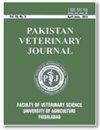Phenolic Derivatives with Antioxidant and Anti-Inflammatory Activities: An in Silico, in vitro and in vivo Study
IF 5.4
3区 农林科学
Q1 VETERINARY SCIENCES
引用次数: 0
Abstract
Received: Revised: Accepted: Published online: January 10, 2019 January 29, 2019 January 30, 2019 April 06, 2019 Polyphenols are widely distributed in nature having broad spectrum of biological activities. Most of the biological effects produced by polyphenols are largely attributed to their anti-inflammatory and antioxidant potential. The current research work describes the anti-inflammatory and antioxidant potential of newly synthesized phenolic derivatives (T2, T5, T6, T7 & T8) through in silico, in vitro and in vivo approach. The docking studies were performed against NADPH oxidase (PDB ID 3A1F-) and cyclooxygenase (COX-2 with PDB ID 5KIR Homosapien) using in silico techniques. Amongst phenolic derivatives (T2, T5, T6, T7 &T8) T2 and T6 exhibited maximum binding affinity with target protein NADPH oxidase (6.2 and -6.3 Kcal/mol respectively). However, in case of COX-2 as target protein, all the five newly synthesized phenolic derivatives showed encouraging results. In particular, T2 and T8 with binding affinity values -7.9 Kcal/mol and -8.0 Kcal/mol respectively which are promising than Ibuprofen with binding affinity -6.6 Kcal/mol. Then in vitro antioxidant potential of phenolic derivatives was analyzed through total reducing power, total antioxidant capacity and DPPH (1, 1-diphenyl2picryl-hydrazyl) assay. T2 and T6 showed antioxidant potential with IC50 values of 25.03μg/ml and 37.21 μg/ml respectively as compared to 15.14 μg/ml with respect to ascorbic acid. In vivo anti-inflammatory potential was determined through carrageenan induced paw edema which resulted in T2 with promising percentage edema inhibition (68.64±3.34) as compare to standard piroxicam (83.84±3.87). Amongst all phenolic derivatives T2 has promising results in in silico, in vitro and in vivo studies. ©2019 PVJ. All rights reserved具有抗氧化和抗炎活性的酚类衍生物:体外和体内研究
接收日期:修订日期:接受日期:在线发布日期:2019年1月10日2019年1月份29日2019年01月30日2019年04月06日多酚广泛分布于自然界,具有广泛的生物活性。多酚产生的大多数生物效应在很大程度上归因于其抗炎和抗氧化潜力。目前的研究工作描述了新合成的酚类衍生物(T2、T5、T6、T7和T8)通过硅、体外和体内方法的抗炎和抗氧化潜力。使用计算机技术对NADPH氧化酶(PDB ID 3A1F-)和环氧合酶(COX-2与PDB ID 5KIR Homosapien)进行对接研究。在酚类衍生物(T2、T5、T6、T7和T8)中,T2和T6表现出与靶蛋白NADPH氧化酶的最大结合亲和力(分别为6.2和-6.3 Kcal/mol)。然而,在COX-2作为靶蛋白的情况下,所有五种新合成的酚类衍生物都显示出令人鼓舞的结果。特别地,T2和T8的结合亲和力值分别为-7.9 Kcal/mol和-8.0 Kcal/mmol,这比结合亲和力为-6.6 Kcal/mole的布洛芬更有希望。然后通过总还原力、总抗氧化能力和DPPH(1,1-二苯基-2-二芳基-肼)测定分析了酚类衍生物的体外抗氧化潜力。T2和T6表现出抗氧化潜力,IC50值分别为25.03μg/ml和37.21μg/ml,而抗坏血酸的IC50值为15.14μg/ml。通过卡拉胶诱导的爪水肿测定了体内抗炎潜力,与标准吡罗昔康(83.84±3.87)相比,T2具有良好的水肿抑制百分比(68.64±3.34)。在所有酚类衍生物中,T2在计算机、体外和体内研究中都有良好的结果。©2019 PVJ。保留所有权利
本文章由计算机程序翻译,如有差异,请以英文原文为准。
求助全文
约1分钟内获得全文
求助全文
来源期刊

Pakistan Veterinary Journal
兽医-兽医学
CiteScore
4.20
自引率
13.00%
发文量
0
审稿时长
4-8 weeks
期刊介绍:
The Pakistan Veterinary Journal (Pak Vet J), a quarterly publication, is being published regularly since 1981 by the Faculty of Veterinary Science, University of Agriculture, Faisalabad, Pakistan. It publishes original research manuscripts and review articles on health and diseases of animals including its various aspects like pathology, microbiology, pharmacology, parasitology and its treatment. The “Pak Vet J” (www.pvj.com.pk) is included in Science Citation Index Expended and has got 1.217 impact factor in JCR 2017. Among Veterinary Science Journals of the world (136), “Pak Vet J” has been i) ranked at 75th position and ii) placed Q2 in Quartile in Category. The journal is read, abstracted and indexed internationally.
 求助内容:
求助内容: 应助结果提醒方式:
应助结果提醒方式:


